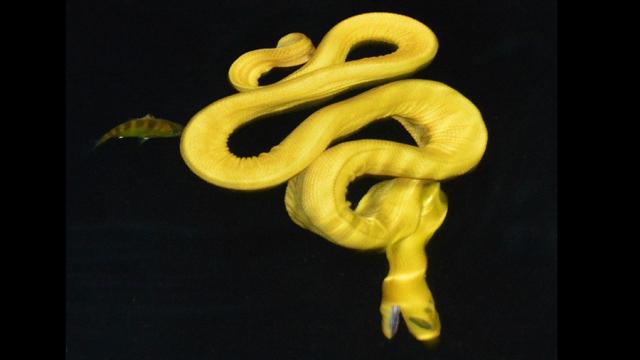A new subspecies of sea snake has been discovered off the coast of Costa Rica, and it has a unique hunting style that’s never been seen before in aquatic reptiles. Hanging from the surface like a coiled spring, it preys upon unsuspecting fish as they swim below.
Image: Brooke L. Bessesen, Gary J. Galbreath/ZooKeys
As described in the science journal ZooKeys, the sea snake “opportunistically” feeds on small fish by hanging upside down in a coiled, or sinusoidal, position just below the water surface, and it only does so only at night. It’s just one of several differences that distinguish it from its closest living relative, Hydrophis platurus, a yellow sea snake that lives about 23km away in cooler waters. The researchers who conducted the analysis, Brooke Bessesen from the Phoenix Zoo and Gary Galbreath from Northwestern University, say the newly discovered snake may actually belong to an entirely new species of sea snake, but for now they’re content to designate it a subspecies, dubbed Hydrophis platurus xanthos.

Image: Brooke L. Bessesen, Gary J. Galbreath/ZooKeys
This half-metre-long snake lives in the warm and choppy waters of Golfo Dulce in Costa Rica, and it’s had to adapt to the harsh conditions found there. Water temperatures in this area can reach as high as 32.6C, which is dangerously close to what sea snakes can endure. What’s more, these waters can become anoxic, where the dissolved oxygen falls to incredibly low levels (sea snakes pull oxygen from the water through their skin, so anoxic waters could cause them to suffocate).
But as the new study points out, H. platurus xanthos has evolved several strategies that allow it to survive in these turbulent waters. In addition to adopting its unique ambush strategy (H. platurus also hunts for fish by floating on the surface, but they don’t go into the sinusoidal ambush position), this sea snake is smaller than its parent species, and it features a uniform yellowish colour across its body (by contrast, Hydrophis platurus has some black and yellow patterning). Its lighter colouring, say the researchers, likely helps with temperature regulation in the warm waters, while the nocturnal hunting strategy allows it to avoid the hot daytime temperatures at the surface. These animals spend about 99 per cent of their lives at depths of 20 to 50m where it’s much cooler.
Bessesen and Galbreath based their study on observations made of 154 different specimens (123 free-ranging and 21 held in museums) from 2010 to 2017. Sadly, these snakes — which are only being described now — are already considered endangered. Their territory is limited to 320km2 in an unprotected area. Collectors have already started to poach the sea snakes, and climate change threatens to make large swaths of ocean water too warm for them to survive.
“Hopefully this globally unique population can continue to offer both scientists and conservation-conscious tourists a worthy subject of observation and study,” note the authors in a press release.
[ZooKeys]
